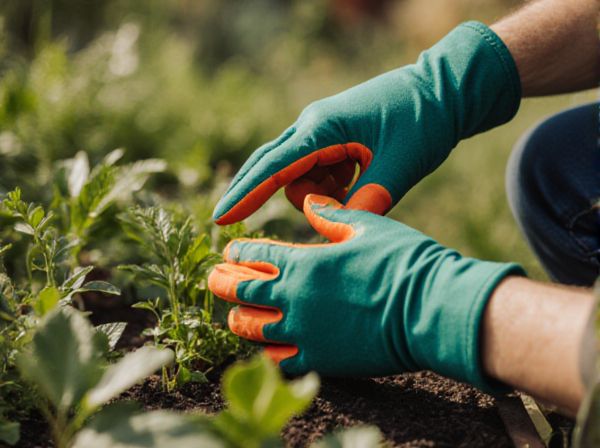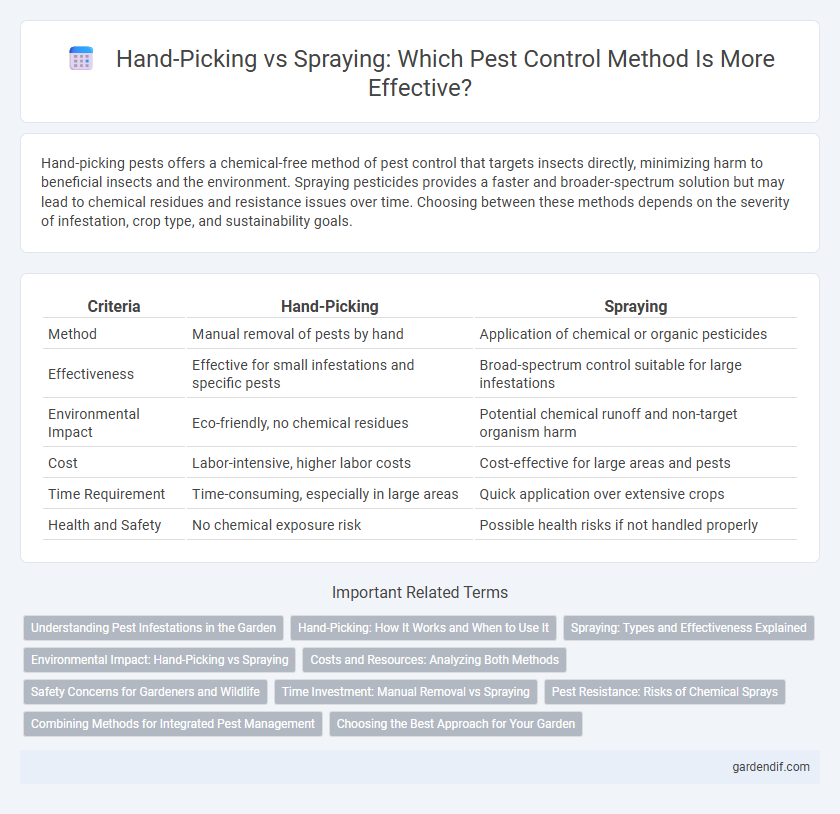
Hand-picking vs Spraying Illustration
Hand-picking pests offers a chemical-free method of pest control that targets insects directly, minimizing harm to beneficial insects and the environment. Spraying pesticides provides a faster and broader-spectrum solution but may lead to chemical residues and resistance issues over time. Choosing between these methods depends on the severity of infestation, crop type, and sustainability goals.
Table of Comparison
| Criteria | Hand-Picking | Spraying |
|---|---|---|
| Method | Manual removal of pests by hand | Application of chemical or organic pesticides |
| Effectiveness | Effective for small infestations and specific pests | Broad-spectrum control suitable for large infestations |
| Environmental Impact | Eco-friendly, no chemical residues | Potential chemical runoff and non-target organism harm |
| Cost | Labor-intensive, higher labor costs | Cost-effective for large areas and pests |
| Time Requirement | Time-consuming, especially in large areas | Quick application over extensive crops |
| Health and Safety | No chemical exposure risk | Possible health risks if not handled properly |
Understanding Pest Infestations in the Garden
Hand-picking pests targets specific insect infestations, allowing for precise removal of beetles, caterpillars, or aphids without harming beneficial insects or plants. Spraying pesticides provides broad-spectrum control but risks disrupting garden ecology and may lead to pesticide resistance in common garden pests like whiteflies and spider mites. Understanding pest behavior, lifecycle, and population density is critical to choosing between hand-picking for minor infestations and spraying for extensive, hard-to-manage pest outbreaks.
Hand-Picking: How It Works and When to Use It
Hand-picking involves manually removing pests like caterpillars, beetles, or aphids from plants, making it highly effective for small infestations in gardens or greenhouses. This eco-friendly method targets visible pests directly, minimizing chemical usage and preventing pesticide resistance while preserving beneficial insect populations. Best used in early pest stages or sensitive crops, hand-picking is labor-intensive but valuable for organic farming and integrated pest management strategies.
Spraying: Types and Effectiveness Explained
Spraying methods in pest control include contact, systemic, and residual insecticides, each targeting pests differently for maximum effectiveness. Contact sprays kill pests on direct contact, systemic sprays are absorbed by plants providing internal protection, and residual sprays remain effective on surfaces for extended periods. Choosing the right type depends on the pest species, infestation severity, and environmental considerations to ensure efficient pest management.
Environmental Impact: Hand-Picking vs Spraying
Hand-picking pests eliminates chemical use, preserving soil and water quality while protecting beneficial insects and biodiversity. Spraying pesticides can cause harmful runoff, contaminating ecosystems and leading to resistance in pest populations. Choosing hand-picking reduces environmental pollution and supports sustainable pest management practices.
Costs and Resources: Analyzing Both Methods
Hand-picking pests requires minimal financial investment but demands significant labor and time, making it resource-intensive for large infestations. Spraying involves the cost of pesticides and application equipment but offers faster pest control with less manual effort. Evaluating cost-effectiveness depends on infestation scale, workforce availability, and environmental impact considerations.
Safety Concerns for Gardeners and Wildlife
Hand-picking pests minimizes chemical exposure, making it safer for gardeners and preserving beneficial insects, birds, and pollinators in the ecosystem. Spraying pesticides often introduces toxic substances that can linger on plants, soil, and water sources, posing health risks to humans, pets, and non-target wildlife. Choosing manual removal methods supports sustainable gardening by reducing chemical contamination and promoting biodiversity.
Time Investment: Manual Removal vs Spraying
Hand-picking pests demands significant time and consistent effort, especially in large infestations or dense vegetation, making it labor-intensive but precise for targeting specific pests. Spraying pesticides covers a broader area quickly and efficiently, reducing immediate time investment but potentially requiring repeated applications for long-term control. Balancing these methods involves considering the scale of infestation, the urgency of pest removal, and environmental impact.
Pest Resistance: Risks of Chemical Sprays
Hand-picking pests reduces the risk of developing pesticide-resistant populations, maintaining long-term pest control effectiveness without harmful chemical exposure. Chemical sprays often lead to pest resistance due to repeated use, necessitating stronger, more frequent applications that can harm beneficial insects and the environment. Integrating manual removal with targeted, minimal spraying can slow resistance buildup and enhance sustainable pest management.
Combining Methods for Integrated Pest Management
Combining hand-picking with targeted spraying enhances Integrated Pest Management (IPM) by reducing chemical use while effectively controlling pest populations. Manual removal of pests complements selective insecticide application, minimizing environmental impact and promoting sustainable agriculture. This integrated approach boosts crop health and yields by balancing mechanical and chemical pest control strategies.
Choosing the Best Approach for Your Garden
Hand-picking pests offers a precise, chemical-free method ideal for small gardens and organic cultivation, effectively reducing damage to beneficial insects and plants. Spraying pesticides provides rapid control over widespread infestations but carries risks of chemical resistance, environmental impact, and potential harm to pollinators. Selecting the best approach depends on pest severity, garden size, crop sensitivity, and environmental considerations to balance efficiency with sustainability.
Hand-picking vs Spraying Infographic

 gardendif.com
gardendif.com